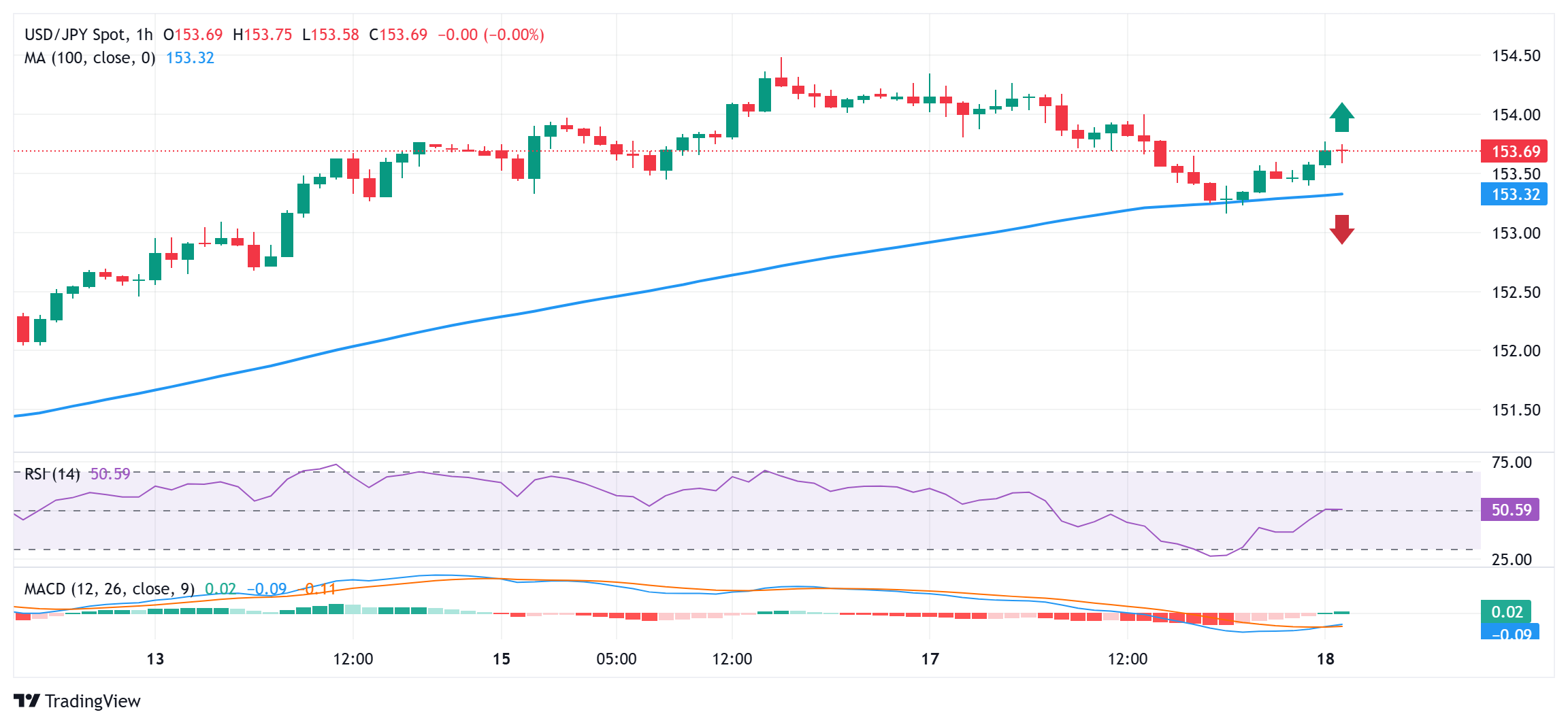- The Japanese Yen attracts some sellers following the discharge of Japanese Commerce Stability information.
- Bets that the BoJ will hold charges unchanged and elevated US bond yields additionally weigh on the JPY.
- Merchants keenly await the essential FOMC resolution, forward of the BoJ coverage replace on Thursday.
The Japanese Yen (JPY) struggles to capitalize on the day before today’s modest restoration positive aspects in opposition to its American counterpart and attracts recent sellers throughout the Asian session on Wednesday. Knowledge launched earlier as we speak confirmed that Japan’s Commerce Stability unexpectedly improved in November on the again of robust progress in exports, although a fall in imports pointed to a weak native demand. This, together with the unsure financial outlook amid issues about US President-elect Donald Trump’s tariff plans, reaffirms expectations that the Financial institution of Japan (BoJ) will hold rates of interest regular later this week and undermines the JPY.
In the meantime, the prospects for a much less dovish Federal Reserve (Fed), together with expectations that Trump’s insurance policies could result in a rise in authorities borrowing and increase inflation, stay supportive of elevated US Treasury bond yields. This seems to be one other issue weighing on the lower-yielding JPY, although a softer danger tone helps restrict deeper losses. The JPY bears may additionally chorus from putting aggressive bets and choose to attend on the sidelines forward of the important thing central financial institution occasion dangers. The Fed will announce its resolution on the finish of a two-day assembly later as we speak, adopted by the BoJ financial coverage replace on Thursday.
Japanese Yen continues to be undermined by BoJ charge hike uncertainty
- A report revealed by Japan’s Ministry of Finance confirmed on Wednesday that the nation’s commerce deficit unexpectedly improved in November and got here in at ¥117.6 billion in comparison with October’s deficit of ¥462.1 billion.
- The advance was pushed by robust progress in exports, which elevated by 3.8% year-on-year in November amid a weaker Japanese Yen and a pickup in demand from Japan’s largest buying and selling companions – the US and China.
- The upbeat studying, nevertheless, was offset by a 3.8% decline in Japanese imports, which, together with expectations that the Financial institution of Japan won’t hike rates of interest later this week, attracts recent sellers across the JPY.
- The yield on the benchmark 10-year US authorities bond shot to its highest stage since November 22 following the discharge of US Retail Gross sales information, which underscored strong client spending and financial resilience.
- The Commerce Division reported that gross sales on the retail stage elevated by 0.7% in November in comparison with the 0.5% progress recorded within the earlier month, whereas gross sales ex Autos fell in need of expectations and rose 0.2%.
- The report, in the meantime, had little influence on market expectations that the Federal Reserve will decrease borrowing prices for the third time, by 25 foundation factors on the finish of a two-day coverage assembly later this Wednesday.
- Nevertheless, indicators that the progress in the direction of bringing inflation again to the central financial institution’s 2% goal recommend that the Fed might undertake a extra cautious stance and pause its rate-cutting cycle on the January coverage assembly.
- Therefore, traders will scrutinize the up to date financial projections, which embrace the so-called dot plot, and Fed Chair Jerome Powell’s feedback on the post-meeting press convention for cues in regards to the rate-cut path.
- The market consideration will then shift to the essential BoJ coverage resolution, scheduled throughout the Asian session on Thursday, which ought to additional contribute to offering a recent directional impetus to the USD/JPY pair.
USD/JPY might confront some resistance close to 154.00; bullish potential appears intact

From a technical perspective, the emergence of some dip-buying on Wednesday comes on prime of the latest breakout by way of the crucial 200-day Easy Transferring Common (SMA) and favors bullish merchants. Furthermore, oscillators on the each day chart have been gaining optimistic traction and are nonetheless removed from being within the overbought territory, suggesting that the trail of least resistance for the USD/JPY pair is to the upside. Any additional transfer up, nevertheless, would possibly face some resistance close to the 154.00 mark forward of the 154.45-154.50 area, or a three-week prime touched on Monday. A sustained transfer past the latter ought to pave the best way for a transfer in the direction of reclaiming the 155.00 psychological mark. The momentum might prolong additional in the direction of the following related hurdle close to mid-155.00s en path to the 156.00 mark and the 156.25 provide zone.
On the flip aspect, the 153.15 space, or the in a single day swing low, now appears to guard the fast draw back. Some follow-through promoting beneath the 153.00 mark might drag the USD/JPY pair again in the direction of the 200-day SMA pivotal help, close to the 152.15 area. Failure to defend the mentioned help ranges would possibly shift the bias in favor of bearish merchants and make spot costs susceptible to speed up the slide in the direction of the 151.00 spherical determine en path to the 150.00 psychological mark.
Japanese Yen FAQs
The Japanese Yen (JPY) is among the world’s most traded currencies. Its worth is broadly decided by the efficiency of the Japanese financial system, however extra particularly by the Financial institution of Japan’s coverage, the differential between Japanese and US bond yields, or danger sentiment amongst merchants, amongst different elements.
One of many Financial institution of Japan’s mandates is foreign money management, so its strikes are key for the Yen. The BoJ has immediately intervened in foreign money markets typically, typically to decrease the worth of the Yen, though it refrains from doing it usually attributable to political issues of its important buying and selling companions. The BoJ ultra-loose financial coverage between 2013 and 2024 triggered the Yen to depreciate in opposition to its important foreign money friends attributable to an rising coverage divergence between the Financial institution of Japan and different important central banks. Extra not too long ago, the regularly unwinding of this ultra-loose coverage has given some help to the Yen.
Over the past decade, the BoJ’s stance of sticking to ultra-loose financial coverage has led to a widening coverage divergence with different central banks, notably with the US Federal Reserve. This supported a widening of the differential between the 10-year US and Japanese bonds, which favored the US Greenback in opposition to the Japanese Yen. The BoJ resolution in 2024 to regularly abandon the ultra-loose coverage, coupled with interest-rate cuts in different main central banks, is narrowing this differential.
The Japanese Yen is commonly seen as a safe-haven funding. Which means that in occasions of market stress, traders usually tend to put their cash within the Japanese foreign money attributable to its supposed reliability and stability. Turbulent occasions are more likely to strengthen the Yen’s worth in opposition to different currencies seen as extra dangerous to spend money on.
